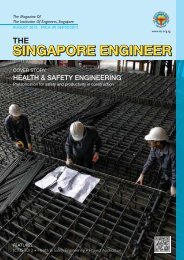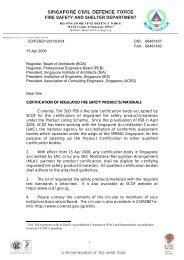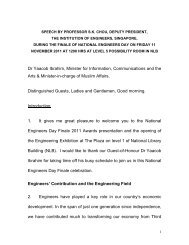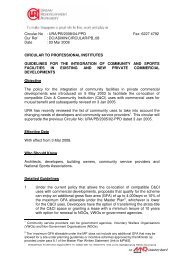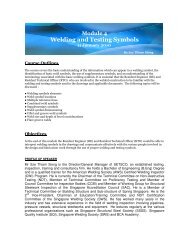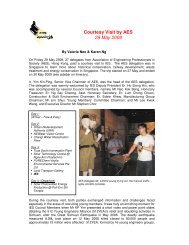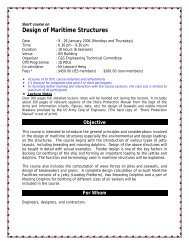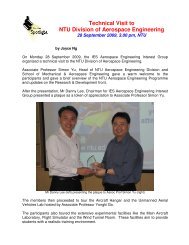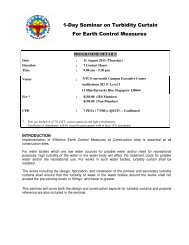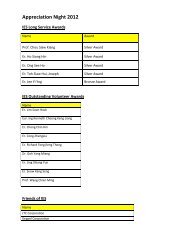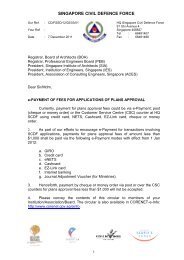THE SINGAPORE ENGINEER - Institution of Engineers Singapore
THE SINGAPORE ENGINEER - Institution of Engineers Singapore
THE SINGAPORE ENGINEER - Institution of Engineers Singapore
Create successful ePaper yourself
Turn your PDF publications into a flip-book with our unique Google optimized e-Paper software.
NEWS COVER STORY<br />
BCA’s plan for improved accessibility<br />
Accessibility in <strong>Singapore</strong>’s built environment has improved<br />
over the years. In response to the recommendations <strong>of</strong> the<br />
Committee on Ageing Issues, BCA developed its Accessibility<br />
Masterplan in 2006. Since then it has facilitated the following key<br />
improvements in the built environment:<br />
• Close to 100% <strong>of</strong> public buildings that are frequented by<br />
general public are provided with at least basic accessibility.<br />
These include community clubs, government <strong>of</strong>fices, hospitals /<br />
polyclinics, libraries, MRT stations, bus interchanges / terminals,<br />
sport facilities, market and food centres, etc.<br />
• 88% <strong>of</strong> buildings along Orchard Road are now provided with<br />
at least basic accessibility, up from 41% in 2006.<br />
• More than 2,000 buildings have at least basic accessibility<br />
features, and it is published on the Friendly Buildings Portal.<br />
(http://www.friendlybuildings.sg)<br />
The first strategic thrust <strong>of</strong> the masterplan is to improve the<br />
design <strong>of</strong> new buildings and infrastructure so that the built<br />
environment is seamlessly connected and accessible not only to<br />
wheelchair users but also the elderly, families with children,and<br />
people with other disabilities. The mandatory requirement in<br />
the Accessibility Code, which was introduced in 1990, has led<br />
the way in achieving barrier-free accessibility in new buildings<br />
and those undergoing major addition and alteration works.<br />
The code was reviewed and enhanced thrice. It incorporates<br />
principles <strong>of</strong> Universal Design (UD), which take into<br />
consideration the physical, social and psychological needs <strong>of</strong> all<br />
possible users. UD features go beyond basic accessibility and<br />
include the provision <strong>of</strong> nursing rooms, smaller sized toilet<br />
facilities for children, and ergonomic features such as rounded<br />
edges. In the current review to be completed by the end this<br />
year, BCA together with the key stakeholders such as developers,<br />
architects, relevant government agencies, along with volunteer<br />
welfare associations and educational institutions will consider<br />
the inclusion <strong>of</strong> some <strong>of</strong> these Universal Design features in the<br />
Accessibility Code.<br />
Specifically, the stakeholders include <strong>Singapore</strong> Institute <strong>of</strong><br />
Architects (SIA), Real Estate Developers Association <strong>of</strong><br />
<strong>Singapore</strong> (REDAS), <strong>Singapore</strong> Association for Occupational<br />
Therapists (SAOT), National University <strong>of</strong> <strong>Singapore</strong> (NUS)<br />
and voluntary welfare associations such as Handicaps Welfare<br />
Association (HWA), Disabled People’s Association (DPA),<br />
<strong>Singapore</strong> Association <strong>of</strong> the Visually Handicapped (SAVH) and<br />
<strong>Singapore</strong> Action Group <strong>of</strong> Elders (SAGE).<br />
The second strategic thrust is focused on tackling future<br />
challenges in improving the accessibility <strong>of</strong> existing buildings built<br />
before 1990, as the mandatory requirements in the Accessibility<br />
Code do not apply retrospectively. Since upgrading to provide<br />
at least basic accessibility for pre-1990 buildings is on a voluntary<br />
basis, the challenge is to improve accessibility to these older<br />
buildings.<br />
Since 2006, BCA has been working with other public agencies to<br />
put in place a medium-term plan to upgrade their building stock.<br />
As <strong>of</strong> February 2012, almost all these public buildings frequented<br />
by the public have achieved at least basic accessibility. Examples<br />
<strong>of</strong> such buildings are community clubs, government <strong>of</strong>fices,<br />
hospitals/polyclinics, libraries, MRT stations, bus interchanges/<br />
terminals, sport facilities, market and food centres, etc.<br />
To incentivise the upgrading <strong>of</strong> existing private sector buildings,<br />
BCA introduced a five-year, S$ 40 million Accessibility Fund (AF)<br />
which was set up to help defray the cost <strong>of</strong> upgrading. As <strong>of</strong><br />
February <strong>of</strong> this year, 101 applications were approved. These<br />
include buildings like hotels, commercial and religious buildings.<br />
To encourage more owners <strong>of</strong> existing private sector buildings<br />
to upgrade their buildings, BCA will be extending the fund by<br />
another five years to 2016.<br />
The fund co-pays up to 80% <strong>of</strong> the cost for providing basic<br />
accessibility features to existing private buildings (except landed<br />
residential properties), subject to a cap <strong>of</strong> S$ 300,000 per<br />
project. BCA hopes that more building owners can benefit<br />
from the funding and consider coming on board to enhance<br />
the accessibility and user-friendliness <strong>of</strong> their buildings, which will<br />
eventually benefit users <strong>of</strong> these buildings and infrastructure.<br />
The third thrust <strong>of</strong> the masterplan sets out to ensure that<br />
accessible facilities provided are still available for their intended<br />
use and not removed or altered (for example, using the toilet<br />
for wheelchair users for storage, or converting accessible car<br />
parking lots to normal car parking lots).<br />
Regulations are in place to ensure accessible facilities are maintained.<br />
To-date, BCA has sent out a number <strong>of</strong> advice notices to ensure<br />
continued compliance, upon feedback from the public.<br />
ADVERTISERS’ INDEX<br />
ESTEEM INNOVATION –––––– INSIDE FRONT COVER<br />
JEC COMPOSITES ––––––––––––––––––––––– – PAGE 47<br />
MANCHESTER –––––––––––––– OUTSIDE BACK COVER<br />
BUSINESS SCHOOL<br />
MAPEI FAR EAST–––––––––––––– INSIDE BACK COVER<br />
PHILIPS ELECTRONICS ––––––––––––––––––––– PAGE 3<br />
SCHNEIDER ELECTRIC <strong>SINGAPORE</strong> ––––––– –– PAGE 5<br />
SCHNEIDER ELECTRIC IT <strong>SINGAPORE</strong> ––––––– PAGE 7<br />
WESTRADE GROUP LTD ––––––––––––––––––– PAGE 9<br />
48 <strong>THE</strong> <strong>SINGAPORE</strong> <strong>ENGINEER</strong> April 2012



